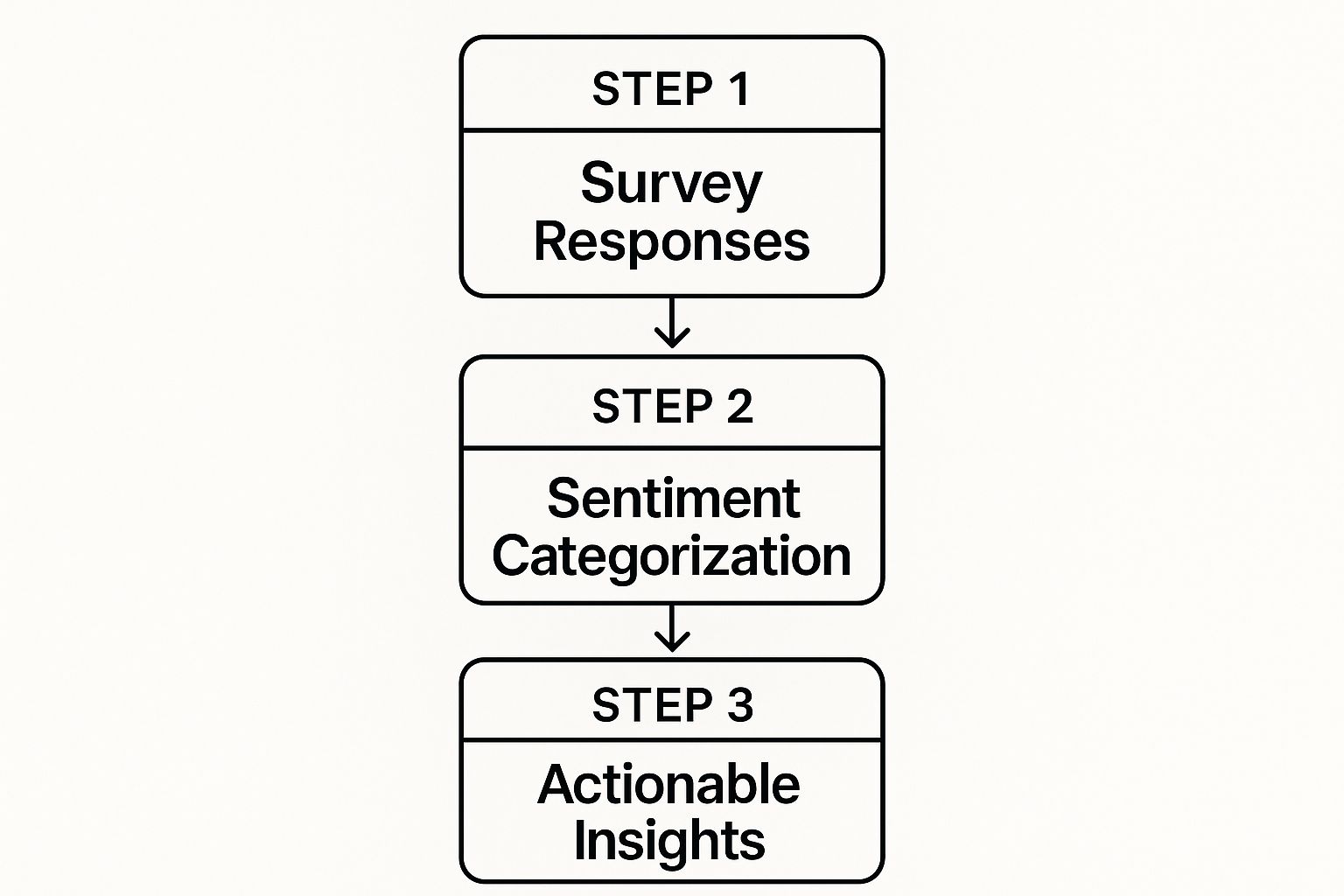Voice of Customer Analysis for Business Growth
Unlock growth with our guide to voice of customer analysis. Learn to collect, analyze, and act on customer feedback to improve your products and services.

Voice of customer analysis is all about systematically gathering what your customers are saying, figuring out what they really mean, and then actually doing something about it. It’s way more than just collecting reviews. The real magic happens when you turn customer complaints, wishes, and passing comments into actionable business intelligence. This whole process is designed to help you make smarter decisions that keep customers happy and, in turn, grow your business.
Why Voice of Customer Analysis Matters Now

Trying to run a business without listening to your customers is like trying to navigate a ship in a storm without a compass. You’re just guessing. Voice of customer (VoC) analysis is that compass. It gives you the direction you need to steer your company through a crowded market, helping you move from guessing what customers want to knowing what they need.
This isn't just about glancing at satisfaction scores. It's about taking all those scattered bits of feedback—from support tickets, social media rants, and survey answers—and weaving them into a single, clear picture of the customer experience. This is how you finally uncover the "why" behind what your customers do.
Beyond Listening to Understanding
A proper VoC program isn't passive. It's an active strategy for making your business better, day in and day out. It helps you shift from a reactive mode (scrambling to fix problems) to a proactive one (stopping those problems from ever happening). When you truly understand the root cause of a complaint or know which specific feature makes customers smile, you can make decisions with confidence.
By digging into feedback, you can pinpoint the exact moments of friction in the customer journey or spot unmet needs that could become your next big market opportunity. For instance, if you notice a pattern of customers mentioning a clunky checkout process, that's not just a handful of complaints. It's a clear data point showing you a direct barrier to revenue.
The Foundation of Customer-Centric Growth
At the end of the day, a solid VoC program is the engine that drives sustainable growth. Companies that consistently bake customer feedback into their strategic planning are simply better at building products people love, creating marketing that connects, and delivering service that earns loyalty. You create a powerful feedback loop where the people who matter most—your customers—are guiding your next move.
This isn't just a feel-good exercise; it delivers real, bottom-line results:
- Reduced Customer Churn: When you spot and fix pain points early, you give customers fewer reasons to look elsewhere.
- Increased Customer Loyalty: People stick around when they feel heard and see their feedback making a difference. It builds incredible trust.
- Informed Product Development: VoC insights tell you which feature requests to prioritize and how to shape your product roadmap, so you’re building what people will actually pay for.
This guide will walk you through how to turn all that customer chatter into your company's most valuable asset.
How to Collect Customer Feedback Effectively

Before you can analyze the voice of your customer, you need to actually hear it. But where does this valuable feedback come from? The most successful strategies don't just stick to one channel. Instead, they blend different methods to capture what customers say, what they do, and what their actions imply.
Think of it like being a detective piecing together a case. You wouldn't rely on just one witness statement. You'd gather interviews, look for physical clues, and run background checks to see the whole picture. In the world of customer feedback, these clues fall into three main categories: direct, indirect, and inferred.
Direct Feedback: Just Ask Them
This is the most straightforward approach of all: you ask a question, and your customer gives you an answer. Direct feedback is solicited, meaning you initiate the conversation. It's fantastic for getting specific, structured answers to your most pressing questions about a product, service, or interaction.
Here are the go-to methods for direct feedback:
- Surveys: These are the workhorses of VoC programs. You can use Net Promoter Score (NPS) to gauge loyalty, Customer Satisfaction (CSAT) to measure happiness with a specific touchpoint, or Customer Effort Score (CES) to find out how easy you are to do business with.
- Interviews: Nothing beats a one-on-one conversation for deep, qualitative insights. Interviews let you dig deeper, ask follow-up questions, and really understand the "why" behind a customer's feelings.
- Focus Groups: Bringing a small group of customers together for a guided discussion can uncover shared opinions and spark ideas you never would have thought of on your own.
Imagine a retail brand sending a quick CSAT survey right after an online purchase. That gives them immediate, direct feedback on how smooth (or clunky) their checkout process was.
Indirect Feedback: Listen to the Conversation
Indirect feedback is what customers say about you when they don't think you're in the room. It’s completely unsolicited, raw, and unfiltered, offering a candid look at how your brand is perceived in the wild.
Tuning into these public conversations is no longer optional. In fact, companies that actively listen and respond to feedback can slash churn by up to 25% and boost customer satisfaction by 30%. You can learn more about how VoC platforms drive these results from this in-depth article.
So, where do you find this feedback?
- Social Media: Keep an ear to the ground on platforms like X (formerly Twitter), Facebook, and Instagram for brand mentions, hashtags, and relevant conversations.
- Online Review Sites: Platforms like Yelp, G2, or Trustpilot are goldmines of detailed customer experiences, both good and bad.
- Support Transcripts: Your own customer service chats and call logs are packed with insights, revealing common pain points and recurring issues.
Back to our retail brand: if they monitor X for their brand name and see a sudden spike in complaints about shipping delays, that’s powerful, real-time indirect feedback they can act on immediately.
Inferred Feedback: Watch What They Do
Finally, we have inferred feedback. This isn't about what customers say—it's about what their actions tell you. By analyzing user behavior, you can connect the dots and understand their preferences, frustrations, and needs without ever asking a direct question. This quantitative data is perfect for validating the qualitative stories you hear elsewhere.
You're not asking questions; you're observing behavior.
Common sources of inferred data include:
- Website Analytics: Metrics like bounce rate, time spent on a page, and user flow show you exactly where people are getting stuck or losing interest on your site.
- Product Usage Data: For a SaaS company, this could mean tracking which features are most popular, where users drop off in a workflow, or how often they log in.
- Transactional Data: Analyzing purchase history, cart abandonment rates, and customer lifetime value reveals powerful behavioral patterns that speak volumes.
For our retailer, a high cart abandonment rate on the final payment page is a massive red flag. No one is explicitly saying, "your payment process is broken," but their actions scream it. This inferred signal, combined with direct and indirect feedback, gives you the complete story.
Comparing VoC Data Collection Methods
Choosing the right mix of feedback channels depends on what you're trying to learn. Each method offers a unique lens through which to view the customer experience. This table breaks down the three types to help you decide which approach fits your goals.
| Method Type | Examples | Pros | Cons |
|---|---|---|---|
| Direct | Surveys (NPS, CSAT, CES), interviews, focus groups | Highly specific and structured; answers your direct questions. | Can be biased (self-selection); potential for survey fatigue. |
| Indirect | Social media mentions, online reviews, support tickets | Candid and unsolicited; reflects genuine sentiment. | Unstructured and noisy; requires tools to analyze at scale. |
| Inferred | Website analytics, product usage data, purchase history | Objective and quantitative; reveals actual behavior. | Lacks context; you know the "what" but not always the "why." |
Ultimately, a robust VoC program doesn’t rely on just one of these methods. The real magic happens when you weave them together. You can use inferred data to spot a problem (high cart abandonment), look at indirect feedback to understand the chatter (social media complaints about a bug), and then use direct feedback to confirm the issue and test a solution (a targeted survey to affected users).
Turning Customer Data Into Actionable Insights
Collecting customer feedback is a bit like gathering ingredients for a meal. Piling up high-quality produce is a great start, but you don't have a delicious dish until you actually follow a recipe. In the same way, raw feedback—all those survey responses, online reviews, and support tickets—is just data until you analyze it and build a clear plan of action.
This is where the real work of voice of customer analysis begins. It’s the process of taking a mountain of raw, often messy, customer comments and turning it into strategic business insights. Let's walk through a practical, five-step framework to make sense of all that valuable data.
Step 1: Centralize All Your Feedback
First things first, you need to bring all your feedback into one place. Customer opinions are scattered all over the place: in survey tools, across social media, buried in your CRM, and logged in support platforms. Trying to analyze this information in separate silos is not only inefficient, but you’ll also miss crucial connections between different data points.
Centralizing everything gives you a single source of truth. This allows you to see the complete, unified picture of the customer experience instead of just a few isolated snapshots.
Step 2: Clean and Prepare the Data
Let's be honest: raw feedback is often a mess. It's filled with typos, irrelevant comments, or duplicate entries that can completely skew your analysis. Data cleaning is a critical, though sometimes overlooked, step in the process.
This means standardizing formats, correcting obvious errors, and removing anything that doesn't belong. Think of it as prepping your ingredients. A clean dataset ensures your insights are built on a solid foundation of accurate information, preventing you from chasing down false patterns.
The infographic below shows how raw survey data flows through analysis to become a strategic insight.

This visual lays out the journey from collecting raw feedback, to sorting it by sentiment, and finally, pulling out actionable intelligence that can genuinely guide business decisions.
Step 3: Apply Sentiment Analysis
Once your data is clean, you can start digging into what it all means. Sentiment analysis is a great starting point. It uses technology, often powered by AI, to automatically sort feedback into positive, negative, or neutral categories. This gives you a quick, high-level pulse check on customer emotion at scale.
Knowing that 70% of recent comments about your new feature are negative is a powerful, immediate signal that something needs your attention. It helps you quickly prioritize which areas of feedback need a much deeper look.
Step 4: Identify Recurring Themes
Sentiment tells you how customers feel, but theme identification tells you what they are feeling about. This is where you start grouping feedback into specific topics. You’ll begin to spot recurring mentions of things like "slow performance," "confusing user interface," or "excellent customer support."
For instance, a software company might discover that dozens of negative comments are all related to their billing page. This "billing page" theme is far more actionable than just knowing a certain percentage of customers are unhappy. To really nail this, you must understand customer needs on a fundamental level.
Step 5: Perform Root Cause Analysis
The final—and most important—step is to ask "why?" Why is the billing page so confusing? Why do customers find the user interface difficult to navigate? Root cause analysis is the detective work required to uncover the real reasons behind the themes you've identified.
This could involve digging into user session recordings, interviewing the specific customers who left that feedback, or collaborating with your product team to review the design from the ground up. Finding the root cause is the key to creating lasting solutions instead of just slapping on temporary fixes. The VoC analytics process is crucial here, with some companies reporting up to a 40% increase in customer loyalty when they effectively act on these insights.
Key VoC Metrics You Need to Track

It’s one thing to talk about listening to your customers; it’s another to turn those conversations into hard numbers your business can act on. That's where VoC metrics come in. They are the vital signs of your customer relationships, giving you a clear, data-backed picture of what's working and what isn't.
But here’s a pro tip: don't get fixated on a single number. A truly effective voice of customer analysis program blends several key metrics together. This creates a much richer, more complete understanding of customer health. Let’s walk through the essential KPIs that every VoC dashboard needs.
Net Promoter Score (NPS)
You’ve almost certainly seen this one. The Net Promoter Score (NPS) is a powerhouse for measuring long-term loyalty, and it all boils down to a single question: "On a scale of 0-10, how likely are you to recommend our company to a friend or colleague?"
It’s simple, but the answers are incredibly revealing. They sort customers into three distinct groups:
- Promoters (9-10): These are your champions. They’re happy, they keep coming back, and they tell their friends about you.
- Passives (7-8): They're satisfied, but not thrilled. They like you just fine, but they could easily be swayed by a competitor's offer.
- Detractors (0-6): These customers are unhappy. At best, they won't buy from you again; at worst, they'll actively share their bad experience.
To get your score, you just subtract the percentage of Detractors from the percentage of Promoters. The resulting number gives you a quick, high-level pulse check on your brand's overall loyalty.
Customer Satisfaction Score (CSAT)
If NPS is about the long-term relationship, Customer Satisfaction Score (CSAT) is all about the immediate moment. It measures how happy a customer is with a specific interaction, like a support call or a recent purchase.
The question is direct: "How satisfied were you with your recent experience?" Customers typically answer on a 1-5 scale. Because it's a transactional metric, CSAT is perfect for pinpointing exact moments of frustration or joy in the customer journey. You can explore a variety of customer satisfaction measurement methods to see what works best for different touchpoints.
Customer Effort Score (CES)
Think about the last time you had to jump through hoops to get a simple problem solved. Frustrating, right? The Customer Effort Score (CES) gets right to the heart of this by asking, "How easy was it to get your issue resolved?"
CES is your secret weapon for finding and eliminating friction. Use it to streamline everything from your checkout process to your support channels. The goal is to make doing business with you feel effortless.
Churn Rate
At the end of the day, it all comes down to this. Churn Rate is the no-nonsense metric that tells you what percentage of customers stopped doing business with you over a certain period. While the other KPIs track feelings and opinions, churn tracks actual behavior—and it hits your revenue directly.
If your churn rate is climbing, it’s a massive red flag. It tells you that something in the customer experience is broken. By looking at churn alongside your NPS, CSAT, and CES data, you can connect the dots, find the root cause, and take smart, targeted action to keep your customers around for the long haul.
Putting Your VoC Strategy Into Practice
Knowing the theory behind Voice of Customer is one thing. But the real magic happens when you start using that knowledge to tackle actual business challenges. When you get it right, a VoC program stops being a data-gathering exercise and becomes the engine that powers smart decisions across your entire company.
When you're systematically listening to what your customers are saying, you can finally stop guessing what they want. It’s all about turning their feedback into real, tangible improvements that make their experience better and, in turn, grow your business. Let's look at a few powerful ways to put this into play.
Prioritize Your Product Roadmap
Figuring out what to build next is one of the toughest jobs for any product team. Do you go after that shiny new feature, fix a pesky bug that’s been around for ages, or completely rethink a clunky workflow? Voice of Customer analysis gives you the clarity to make these calls with confidence.
Instead of working off internal hunches, you can dive into support tickets, feature requests, and product reviews to see what customers are truly asking for. By keeping an eye on how often certain requests pop up and the sentiment behind them, you can pinpoint the updates that will deliver the biggest impact to the most people.
Think about a SaaS company that keeps seeing feedback about how difficult it is to export reports. That task might have been buried deep in their backlog, but the VoC data is screaming that it’s a major point of friction. Bumping that feature up the list directly solves a real customer headache, which is a fast track to better satisfaction and retention.
Refine Your Marketing Messaging
How do you talk about your product? More importantly, is it the same way your customers talk about it? Great marketing connects with people in their own language, hitting on the specific problems they're trying to solve. VoC is a goldmine for finding that authentic customer voice.
By digging into reviews, testimonials, and social media chatter, you can pull out the exact phrases and value props that click with your audience.
- Find the "Aha!" Moments: See which features or benefits your happiest customers rave about the most.
- Uncover the Real Pain Points: Learn, in their own words, what problems your product actually solves for them.
- Borrow Their Language: Weave their natural phrasing into your website copy, ad campaigns, and even your sales scripts.
For example, an e-commerce brand might learn from reading reviews that customers constantly praise the "durability" of their flagship product. The thing is, all the company's marketing has been focused on its "stylish design." Pivoting the messaging to highlight that rugged durability could lead to campaigns that resonate far more deeply with what buyers actually care about.
Improve Customer Service and Support
VoC analysis creates a direct line of sight into the performance of your front-line teams. When you analyze support chat transcripts or post-call surveys, you can quickly spot recurring problems and find opportunities to coach your team or fix a broken process.
Let's say a telecom company notices a sudden drop in their CSAT scores, all tied to billing questions. After digging into the feedback, they realize customers are totally confused by a new invoice design. Armed with that insight, they can proactively publish a help article explaining the changes, retrain their support agents on how to walk customers through the new layout, and watch the call volume and frustration levels drop. It’s a perfect example of turning a negative trend into a win for the customer experience.
How VoC Technology Can Streamline Your Workflow
Trying to manually sort through thousands of customer comments is like trying to find a needle in a haystack. It’s not just inefficient; it’s basically impossible to do well once your business starts to grow. As the feedback piles up, you need more than just elbow grease. This is where dedicated voice of customer analysis technology stops being a nice-to-have and becomes a necessity.
Think of these platforms as a central hub for all your customer feedback. They do the heavy lifting for you, freeing you up to think about strategy instead of getting lost in spreadsheets. The whole point is to move beyond reacting to one-off comments and start seeing the bigger picture hidden in the data.
Automating Data Collection and Analysis
Modern VoC tools automatically pull feedback from all over the place—surveys, support tickets, social media, online reviews—and bring it all into one dashboard. That alone is a huge time-saver. But the real magic happens in the analysis.
Using AI and natural language processing, these platforms can chew through mountains of text in an instant. They can figure out if a comment is positive or negative (sentiment), spot new trends as they emerge, and group feedback by topic, all without you lifting a finger. This is how you turn messy, qualitative feedback into something you can actually measure.
Instead of spending weeks manually tagging customer comments, you get a clear, data-backed summary of what people care about in minutes. That kind of speed gives you a serious edge.
From Raw Data to Business Intelligence
A good VoC platform doesn’t just throw data at you; it gives you clear, actionable intelligence. There's a reason the market for these tools is growing—businesses see how they fuel growth. The leading Voice of Customer platforms for 2025 now use AI to pull insights from every customer touchpoint, offering up dashboards that show you what matters and even how you stack up against the competition. This is how you turn a bunch of random comments into a real strategy.
This ability to find the signal in the noise is what makes these tools so valuable. They connect the dots between what your customers are saying and what your next move should be.
- Intuitive Dashboards: See how trends change over time, slice and dice the data by customer segment, and dig into specific problems with a few clicks.
- Real-Time Alerts: Get a heads-up the moment there’s a spike in negative feedback or a bug report starts trending, so you can jump on it right away.
- Predictive Insights: Some of the more advanced platforms can even spot patterns that suggest a customer is about to leave, giving you a chance to step in before they do.
Ultimately, VoC technology gives you the framework for a feedback program that can actually scale. By exploring different customer feedback analysis tools, you can find a platform that turns customer opinions into a reliable guide for making smarter decisions, much faster.
Frequently Asked Questions About VoC Analysis
Even with a solid plan, kicking off a voice of customer analysis program can raise a lot of practical questions. Nailing the details is what separates a program that fizzles out from one that delivers real, lasting value. Here are some straightforward answers to the common questions we hear from teams as they start to listen to their customers more systematically.
Think of these as the clarifications that will help round out your understanding and let you move forward with your VoC efforts with more confidence. Let's tackle some of the key distinctions and operational hurdles you might run into.
What Is the Difference Between Voice of Customer and Market Research?
People often use Voice of Customer (VoC) and market research interchangeably, but they're really two different tools for different jobs. Here’s a simple way to think about it: VoC is like getting feedback on a meal you’ve already cooked, while market research is asking people what they want for dinner next week.
Voice of Customer analysis zooms in on feedback from your existing customers. The whole point is to improve the products you already have, sharpen your services, and make the overall customer experience better. It's an "inside-out" approach—you're looking at what you offer now and figuring out how to improve it based on the people who actually use it.
Market research, on the other hand, casts a much wider net. It often targets potential customers or a whole market segment to sniff out new opportunities, see if a new idea has legs, or get a handle on emerging trends. It's an "outside-in" strategy focused on discovering what’s next for your business.
How Often Should We Analyze Customer Feedback?
The best voice of customer analysis isn't a one-and-done report; it's a continuous loop. But the right rhythm depends entirely on the type of feedback you're collecting. A multi-speed approach usually works best.
- Real-Time Monitoring: For channels where feedback flows constantly—like social media mentions, support tickets, and online reviews—you need to be listening all the time. This is where automated tools are a lifesaver, helping you spot fires as they start.
- Transactional Cadence: Feedback tied to a specific interaction should be gathered right away. For instance, a CSAT survey should pop up the moment a support chat ends or a customer completes a purchase. The context is fresh, and the feedback is pure.
- Relational Cadence: For broader, relationship-level feedback like Net Promoter Score (NPS), it's better to check in periodically. Sending these surveys quarterly or twice a year gives you enough time to see if your efforts are moving the needle on loyalty without annoying your customers.
The goal is to create a living, breathing stream of insights, not a dusty report that sits on a shelf.
What Is the Biggest Challenge in a VoC Program?
The single biggest pitfall we see in any VoC program is collecting a mountain of data and doing absolutely nothing with it. It's surprisingly common. Companies get great at gathering feedback but fail to "close the loop" by turning those insights into actual changes. This creates a feedback black hole. Customers feel ignored, and your own teams start to think the whole thing is just for show.
A successful VoC program isn't just about listening; it's about a company-wide commitment to action. The real test isn't how much data you collect, but how well you use it to make things better for your customers.
Getting over this hump means assigning clear ownership, creating simple ways to escalate issues, and building a culture where customer input is genuinely treated like gold. It’s about seeing every piece of feedback—good or bad—as a chance to learn and get better. Without that commitment to act, even the most sophisticated VoC tech won't save you.
Ready to stop guessing what your customers want and start building what they’ll pay for? SigOS is an AI-driven product intelligence platform that automatically analyzes your support tickets, sales calls, and chat transcripts to pinpoint the issues costing you revenue and the feature requests that drive growth. Transform customer feedback into your most valuable asset.


